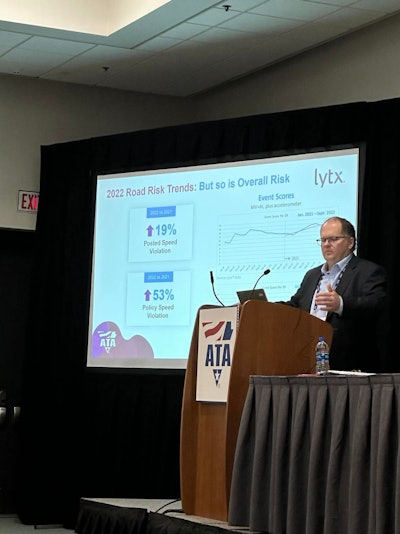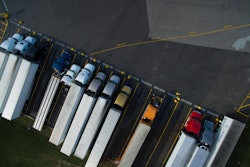
Steve Fields, an America’s Road Team Captain at Yellow Corp. (CCJ Top 250, No. 6) and 36-year professional truck driver, said eight out of 10 cars that pass him on the road are doing something other than driving.
Between distracted driving and attorneys’ radio ads and billboards on interstates claiming to win nuclear verdict-size injury cases, passenger car drivers are the scariest thing truck drivers face on the road.
Technology and defensive driving are the answer. That’s what the safety professionals said during the Future of Safety educational session at the American Trucking Associations Management Conference & Exhibition in San Diego.
Lytx technology has discovered that truck driver attention is up. According to Lytx data, drowsy driving is down 18%, blank stares are down 53%, unbelted drivers are down 24%, and drivers not scanning the roadway are down 7% in 2022 compared to 2021. But the data also shows that road risk trends are up; like posted speed violations (19%) and policy speed violations (53%).
Dan Murray, senior vice president at the American Transportation Research Institute (ATRI), said Federal Highway Administration data shows that 71% of the time, car drivers are at fault in crashes involving a passenger car and a commercial truck. Likewise, the University of Michigan did a study that looked at property damage and injuries – leaving out crashes that resulted in car driver deaths so everyone involved would be present to comment – and found that 68% of the time the car driver was primarily responsible.
“The bottom line is crashes are very rare, and the number of crashes where the truck driver is negligent is extremely small,” Murray said. “So we do need to keep an eye on safety, but it's really important (to focus) on the primary factor, which most of the time is not the truck driver.”
The environment has changed because car drivers are not paying attention to what's going on around them, said Joshua Vance, vice president of safety and compliance at J.B. Hunt Transport (No. 3). While technology like Lytx’s video telematics has been implemented to help fleets improve truck driver behavior, Vance said external cameras that provide video during collisions are just as important because they can exonerate the truck driver when accidents do occur.
Fields said it would also help to have more “biting” laws in place surrounding cellphone usage among car drivers.
But Scopelitis Transportation Consulting Co-director Sean Garney said, while the trucking industry has improved in almost every category related to distraction, there is one category that hasn’t improved: interacting with a device. That could be a cellphone, but it could also be the technology installed in trucks these days, he said.
“Disciplining ourselves as a trucking industry to try to avoid that makes perfect sense and of course educating our younger folks and the car drivers is going to be incredibly important as well, but really teaching our drivers to be defensive and to understand where the risks lay are important,” Garney said. “We work with a lot of trucking companies that want to develop zero-tolerance policies for distraction. Look at the research, and the research says well, eating is a distraction; drinking is a distraction, and that increases my likelihood for a crash. But if my driver is on the road for 10 hours a day, is drinking and eating something I can reasonably prohibit?
“Instead, teaching these avoiding distraction techniques – or defensive driving techniques – to make sure that our eyes aren’t coming off the road when we do, that is incredibly important. I don't think more bells and whistles every year – just walk around the exhibit hall; we have lots of new technology that is going to alert us to different things and keep us safe – but how do we manage that?”
But the panel was quick to note that the car driver isn’t always the problem.
Fields said Yellow has drivers like him that go millions of miles without an accident and some that don’t.
“I've always asked myself, ‘what's the difference between those drivers?,’” he said. “A lot of times … I believe it’s because they don't realize they're going into a bad situation, and it could be a whole host of different things; it can be weather, it can be traffic, it can be a construction zone. As a trainer in Kansas City, I've tried to teach these guys to think about what you're doing … when you go into that construction zone just a little hot because once you go over that hill, you ain't coming back.”
He told an industry-old story about a young truck driver who asks an older truck driver if he thinks he’s going too slow down a mountain. His response: “You'll go down at 100 times too slow, but you’ll only go down it once too fast.”
But there has always been a struggle between safety and schedule, Fields said. He said a lot of trucking companies will prioritize schedule over safety, but it’s important to give drivers time.
Vance said during court cases regarding accidents, prosecutors will look at how much training each individual truck driver – whether involved in the accident or not – received. But that’s not the case when it comes to a car driver.
“I got my driver's license when I was 16 years old, and no one taught me how to be any better,” he said. “If something doesn't change with the way an average person gets and maintains a driver's license, there’s only so much we can do.”
The panel also discussed future cases of safety issues from changing the interstate driver age to allow 18-year-olds to enter the industry to autonomous vehicles.
Murray said statistics from Truckingresearch.org show that 18- to 25-year-olds are safer drivers than those 25 and up. Fields said older drivers get more comfortable and complacent a few years down the road.
“At Yellow, we have more accidents on a bright sun-shiny day than when in snow because you’re focused in the snow,” and that same principle applies to the younger drivers who tend to be more focused because they’re new and more fearful of accidents, Fields said.
But what about their future and their retirement, an audience member asked regarding autonomous trucks.
Lytx Director of Safety Services Gary Johnson said he doesn’t think there will ever be a time when a driver isn’t present in the vehicle.
Fields said he used to worry about the direction toward autonomous trucks, but now he sees it as a helpful hand to the driver. The driver’s job will shift but not go away. He said he wants his company to innovate to be able to compete because if his company does well, it benefits the drivers too.
“Ultimately, the human is the biggest and most important part of that wheel,” Johnson said. “Look at the airline industry; they've had autopilot for how many years? And you still have two individuals up in that plane to address anything that goes wrong. The human aspect will always be key, but it really comes down to the values and the approach when it comes to safety.”
And that means, no matter what technology companies bring into play – from video telematics to autonomous trucks – leadership has to have buy-in. Garney said claiming a safety first motto isn’t enough; the C-suite has to back it.












